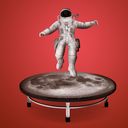The Moon is a jumping off point for Mars

NASA's vision of astronauts walking on Mars hinges on first getting them back to the Moon.
Why it matters: NASA is planning to launch its first test flight of its new Moon rocket today, marking one of the agency's first major steps along a decades-long journey to Mars.
- "We're going to Mars, and we’re going back to the Moon in order to learn to live, to work, to survive,” NASA administrator Bill Nelson said during a press conference in August.
State of play: By using the Moon as a proving ground for technology needed for missions to Mars, NASA says it can make those future missions safer.
- NASA will closely watch how astronauts fare during long stints in low gravity on the Moon and monitor their radiation doses, which will be far higher during a trip to and from Mars and could put their health at serious risk.
- Trips to Mars could also require using resources found on the planet — manufacturing oxygen or rocket fuel from Martian resources for example — so NASA will also start testing that technology on the Moon first.
- “How do you keep humans alive in those hostile conditions?" Nelson said. "And we’re going to learn how to use the resources on the Moon in order to be able to build things in the future as we go — not a quarter of a million miles away, not a three-day journey — but millions and millions of miles away on a months and months if not years-long journey."
- Nelson has said the agency plans to land people on Mars by 2040.
Between the lines: NASA has already started laying the groundwork for exploring Mars with astronauts one day.
- An instrument aboard the Perseverance rover, for example, has already made oxygen from the Martian atmosphere seven times.
- “This is the first demonstration of actually using resources on the surface of another planetary body, and transforming them chemically into something that would be useful for a human mission,” Jeffrey Hoffman of MIT and the deputy principal investigator for the instrument said in a statement.
- NASA has also been figuring out how to grow food on the International Space Station, an activity that could be used on Mars one day as well.
The intrigue: NASA is shoring up international cooperation with its Artemis program that could one day translate to coordination between nations on Mars itself.
- The Artemis Accords — developed by NASA and signed by more than 20 countries — create a framework for how resources on the Moon and Mars should be managed and how exploration should work among nations heading to these distant worlds.
The big picture: NASA has been studying Mars from orbit and using rovers on the surface for decades, but a well-trained astronaut on the ground could be a game-changer for science on the Red Planet.
- A rover's every move tends to be precisely planned out, but a person on Mars can simply walk over to an interesting looking rock or area and sample it or take a closer look.
- And astronauts already dream of it: “Every day that I personally spent on the space station, I looked at it as walking on Mars,” NASA astronaut Reid Wiseman said during the August press conference.